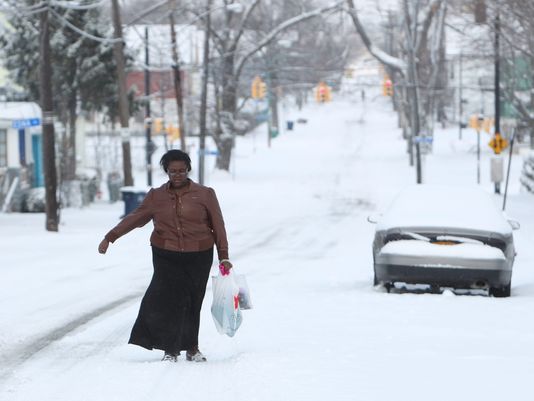A major snowstorm and blizzard-like conditions are expected to affect 100 million people across the Midwest and Northeast.
While the immediate focus was on snow – with up to 10 inches possible in New York City, possibly 18 inches burying New England, and more than 1,800 flights canceled – the cold behind the snowstorm could be crippling.
The high temperature in New York City will be in the teens on Friday during the day and drop to between 5 and 8 degrees in the evening, with the wind chill making it feel well below zero. Lows in Boston will be below zero. Maine could see the mercury drop to minus 30 after dark.
“That is a very, very dangerous set of circumstances,” Massachusetts Gov. Deval Patrick said. He dismissed all state workers at 3 p.m. and urged residents to minimize time outside and be aware of frostbite and hypothermia symptoms.
A second wave of icy weather will hit the nation’s midsection by late Sunday, stretching from the upper Midwest to Kentucky and Tennessee, forecasters said.
Chicago will struggle to get above minus 8 and by Monday morning the wind will make it feel like it’s 40 below zero there.

In Green Bay, Wisconsin, where the Packers host an NFL playoff game Sunday evening, the low temperature could reach minus 18.
Larry Wittmers, a hypothermia expert at the University of Minnesota-Duluth medical school, said it’s not necessarily the coldest areas that face the most peril.
“True hypothermia cases turn up more often in more southern regions because people are not prepared and don’t know what to do,” Larry Wittmers said.
How long people can safely spend outside depends on how wet or windy it is and how they are dressed, he said. Shoveling snow or other exercise can be dangerous because sweat reduces the insulation capability of clothing, and consuming alcohol can speed heat loss and reduce awareness of the cold.
And even though record snowfall is not expected, the cold could make roads even more hazardous because the snow-melting homeowners and road crews use loses effectiveness at between 10 and 20 degrees.
Winter storm warnings and advisories were in effect in 22 states, stretched from Chicago through the New York tri-state region into New England and affecting an area home to more than 90 million people.
Flights were being canceled by the hundred at some of the nation’s busiest airports. Five hundred had been scrapped at Newark, LaGuardia and Kennedy; Boston’s last departure was slated for 8:30 p.m.; almost 600 were off the boards at Chicago’s O’Hare, according to FlightAware.
[youtube 5D-YttEHXvI 650]
